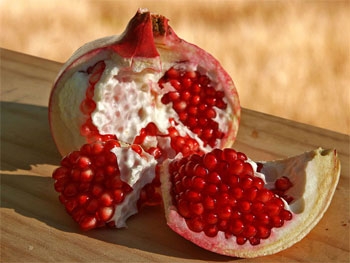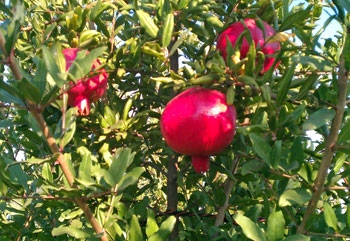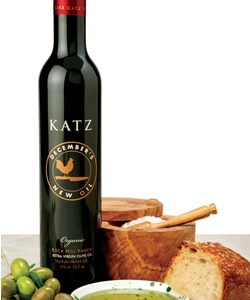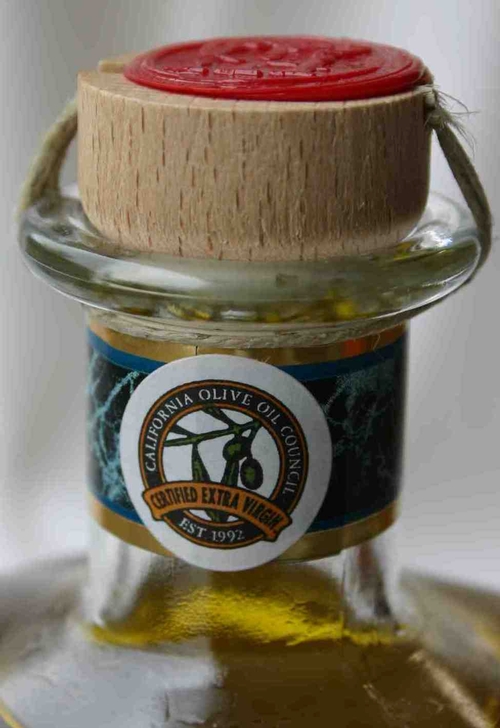Posts Tagged: Vossen
The colorful, healthful pomegranate is a good food and lovely landscape plant
A jewel-toned garnish for California cuisine, antioxidant-rich elixir of good health, drought-resistant tree ideal for desert-like regions in California, the pomegranate has inner beauty and outward resiliency driving its growing popularity.
Pomegranates have been cultivated since ancient times, and are referred to poetically in texts ranging from the Bible to Shakespeare’s Romeo and Juliet. They are unusual among California fruit. Tough, leathery skin protects bright red, tart-sweet juice sacs, called arils, which are separated in groups by white spongy tissue. Inside each sac is an edible seed which contains fiber and unsaturated fat. The red pulp is a good source of potassium and vitamin C.
More a large shrub than a tree, with multiple trunks reaching a height of 15 to 20 feet, pomegranates are adapted to regions with cool winters and hot summers. Beautiful shiny foliage and a long flowering season make them attractive additions to coastal, inland valley and desert landscapes. Pomegranates tolerate a wide range of soil types, but prefer deep, well-drained loams. The best time to plant is in late winter or early spring – just before they leaf out.
Data about the scope of California commercial pomegranate production is hard to find. USDA stopped collecting pomegranate data in 1989 and CDFA groups pomegranates with kumquats, loquats, persimmons, prickly pears and other unusual fruit. UC Cooperative Extension farm advisor Maxwell Norton said county pesticide registration data indicate that five Central Valley counties – Kern, Fresno, Madera, Kings and Tulare – have about 35,000 acres planted to pomegranate. About 500 acres are planted in other counties combined. Kern County has the highest production with about 17,000 acres producing fruit valued at $115 million per year.
UC Cooperative Extension farm advisor Paul Vossen suggests the following standard varieties for backyard plantings:
- Ambrosia – Huge fruit, pale pink skin, similar to Wonderful
- Eversweet – Very sweet. Red skin, clear juice. Good for coastal areas
- Granada – Deep crimson fruit color. Matures early, but needs heat
- Ruby Red – Matures late, but not as sweet or colorful as Wonderful.
- Wonderful – Large, deep red fruit, large, juice red kernels. Small seeds.
For eating or juicing, select pomegranates at grocery stores by weight, not color. The heavier the pomegranate, the more juice inside. Some consumers are deterred from purchasing and eating the raw fruit because they believe it’s difficult to prepare. UC Master Food Preserver Geri Scalzi gives five simple steps that make eating fresh pomegranate easy:
- Cut off the top half an inch below the crown. Four to six sections of pomegranate arils divided by white membrane will be visible.
- Score the leathery skin with a sharp knife along each section.
- Break the pomegranate apart along the score lines. This can be done under water to prevent squirting pomegranate juice, which tends to stain clothing.
- Loosen arils and membranes and drop them into water. The arils will sink, the membranes will float. Skim off the membranes with a slotted spoon.
- Pour the arils and remaining liquid through a strainer.
The pulpy seed sacs are then ready to be eaten plain, tossed in salads, stirred into yogurt or sprinkled over cereal.
For more information on pomegranate production, attend a public meeting at the UC Kearney Agricultural Research and Extension Center, 9240 S. Riverbend Ave., Parlier, from 10 a.m to 1 p.m. Tuesday, Nov. 29. The following topics will be covered:
- Insect pest update, integrated pest management entomologist Walt Bentley
- Black heart disorder and tree decline issues, UC Davis plant pathologist Themis Michailides
- Interesting selections in the USDA germplasm collection, USDA national clonal germplasm representative Jeff Moersfelder
- Irrigation, fertigation & nitrogen use efficiency with drip irrigation, Claude J. Phené, USDA-ARS
- Summary of acreage trends, Merced County farm advisor Maxwell Norton
RSVP to Yolanda Murillo at ymurillo@ucdavis.edu or (559) 600-7285. The $10 registration fee may be paid at the door with cash or check. More information.
Last call for olio nuovo
I’m slow on the artisan EVOO wave. In December, after proofreading the new issue of California Agriculture - Growing Bigger, Better: Artisan Olive Oil Comes of Age, I purchased a bottle for my partner and the next day heard a TV comedian joke about people buying $60 bottles of olive oil for holidays gifts. (Then I felt cheap — I hadn’t spent that much!)
But the tall thin black bottle of December’s New Oil from Katz and Company, near Napa, was so fabulous I decided to start learning the extra virgin olive oil (EVOO) lexicon. Did I know for sure whether it was grassy, buttery, peppery or pungent? It certainly was green. Albert Katz this week told me why: “That’s the chlorophyll in the oil; it’s at its height in olio nuovo,” he said.
When the earliest still-green olives are crushed in November, a strong odor of fresh green fills the mill, he explained. The crush smells like fresh artichoke, even parsley, but most predominantly like grass. Katz has been in the business so long that when he catches a whiff of mown grass he looks around to see whether someone is crushing olives nearby.
Darn it, though, Katz sells their olio nuovo only in December, so it’s over. The limited production and short window of sales for olio nuovo, celebrating the first crush, is a tradition in all the major olive-growing regions of the world, including northern Italy, where the name originates. The oil is always unfiltered, cloudy, and as bold as it’s ever going to be. Katz calls it “the pungency of youth.”
This week sees the very end of the season. McEvoy Ranch has bottles of their olio nuovo for sale at their San Francisco Ferry Building store and online through this weekend (February 6). The McEvoy olio nuovo is green, robust, and peppery — peppery means it has a little burn in the throat, which is a desirable quality. (Bitter is a different matter; it’s tasted on the tongue.) Like all olio nuovo, the McEvoy new oil has sediment in the bottom of the bottle, and it has an unctuous quality, a little pleasantly thick and earthy in the mouth.
With the end of the olio nuovo season comes the release of the oils that have been stored for two months; they are already changing — more mellow, more golden — and the sediment will stay in the storage tanks. As they age through spring and summer, they’ll taste more buttery.
Climate affects the taste of oil. “Terroir” is what the environmental factors are called, explain Paul Vossen and Alexandra Kicenik Devarenne in the California Agriculture article on sensory qualities of olive oils. Katz tastes some roundness and softness in his oil this year, from the cool summer and late harvest.
Different varieties of olive trees produce markedly different aroma compounds. Tuscan varieties, grown by both Katz and McEvoy Ranch, have robust aroma profiles (full-bodied, pungent, complex). A few stores down from McEvoy at the San Francisco Ferry Building, Stonehouse sells its milder EVOO, pressed from Spanish olive oil varieties Mission, Manzanillo, Sevillano, Ascolano and Arbequina. The Stonehouse oil isn’t spicy; it doesn’t burn the throat.
Last week, Katz released its main oils for 2011: Chef’s Pick Organic Extra Virgin and Rock Hill Ranch Extra Virgin. Rock Hill doesn’t taste like the olio nuovo, because a significant proportion of the olives in it are Taggiasca, and they weren’t harvested until after the olio nuovo was made. Chef’s Pick, though, has the same profile, Katz says. Now I know a little of the language, I think I’m going to investigate further and buy a bottle before it sells out. If I wait until summer, I’m told the green will be gone and the grassiness turned more herbal.
For more information on tasting olive oils, check out the UC Davis Olive Center; in August, they have introductory and advanced seminars on sensory evaluation of olive oil.
Paul Vossen is a UC Cooperative Extension farm advisor and expert on olive oil processing tasting; watch his video on tasting here.
Alexandra Kicenik Devarenne showed Sacramento Bee reporter Gina Kim in this video how to taste oil and recognize fustiness.
The California Olive Oil Council website lists farm tours and tasting rooms.
The Olive Oil Times has an archive of articles on tasting, including one on recognizing rancidity.
'Extra virgin' olive oil: What is it and why does it matter?
Dipping fresh bread into olive oil has become a popular alternative to coating it with butter. Olive oil consists of 85 percent unsaturated fats, and when substituted for saturated fat in the diet can promote ”good” cholesterol (high density lipoprotein or HDL), reducing risk of coronary artery disease.
Some olive oils are more beneficial than others. "Extra virgin" olive oil (EVOO), for instance, is extracted from the olive fruit without using heat or chemical solvents. This mechanical process retains the highest amount of natural “phenolic compounds” — antioxidants and anti-inflammatory agents. Such compounds both retard oxidation in the olive oil (keeping it fresh and preventing rancidity) and confer health benefits.
Miller's diagram (above) depicts the fatty acid content of olive oil. PUFA is polyunsaturated fatty acids.
"Antioxidants combat cell and tissue damage due to oxidation, and anti-inflammatory agents reduce inflammation throughout the body. Inflammation can lead to an array of diseases (arthritis, coronary artery disease and more),” said Amy Myrdal Miller, registered dietitian and a program director at The Culinary Institute of America.
When oils are 'refined,' heat or chemical solvents strip away phenolic compounds; the result is often a bland flavor. Mechanically extracted "extra-virgin" oils retain aromatic components. Pungent, peppery and sometimes bitter notes signal that an oil contains phenolics.
The growth of premium olive oil production in California has its roots in 1997, when UC Cooperative Extension Sonoma County Advisor Paul Vossen started the first olive oil taste panel in California to help producers improve oil quality using sensory analysis. (See the January 2011 California Agriculture.)
When it comes to detecting positive and negative attributes of olive oil, human tasters are superior to current chemical analytical methods. Standards to define "extra-virgin" and other grades of oil include both sensory and laboratory measures. The International Olive Council's (IOC) narrow definition specifies that EVOO must show no evidence of heat or chemical solvents. It must have zero median "defects" (as judged by trained taste panels) and more than zero median fruitiness. It must meet requirements for low levels of free fatty acids (too many of these signal degradation) and peroxide levels (a sign of oxidation).
This definition has been adopted by the U.S. Department of Agriculture (USDA) and the states of California, Connecticut and Oregon. Beginning on Oct. 24 of 2010, it became part of new USDA standards for olive oil labeling, which also define "U.S. Virgin," "U.S. Refined" and other grades. Although the standards are voluntary, any manufacturer using this terminology on its label could be held to truth-in-labeling laws.
While the ultimate impact of the new USDA standards will take time, consumers can learn to identify flavor attributes of California olive oils by participating in tastings at vendors that feature artisan products. Also, the
California Olive Oil Council awards an extra-virgin certification seal to member oils that are defect-free.However, the array of olive oils now available at supermarkets can be daunting, and "extra virgin" on the label can be misleading. The UC Davis Olive Center reported in July 2010 that their samples from Sacramento, San Francisco and Los Angeles supermarkets revealed 69 percent of imported EVOO and 10 percent of California olive oil samples labeled as EVOO failed to meet International Olive Council (IOC)/USDA sensory standards for extra virgin olive oil.
Once you identify your favorite olive oil, it should be stored in a cool, dark environment, like a kitchen cabinet removed from the stove, according to Alexandra Vicenik Devarenne, freelance olive oil consultant in Sonoma County. Fluctuations in temperature and light affect the integrity of the health-promoting phenols in extra virgin olive oil.
“When people find out about phenolics and the effects of heat on olive oil, they may question whether it is safe and okay to cook with extra virgin olive oil,” she says. “The heat will destroy some of the health-promoting phenols in the oil, which will change the flavor. The longer the oil is exposed to heat, and the higher the heat, the more phenols will be destroyed.
“However, sautéing in extra virgin olive oil for 5 to 10 minutes over medium heat will have minimal effects on phenols and flavor.”
See more tips on storing and cooking with olive oil.
California farmers produce superior olive oil
California olive oil may cost a little more than the mass-produced imports commonly found at the supermarket, but UC farm advisor Paul Vossen said it is well worth the money.
“Good olive oil imparts delicious, subtle flavors to foods, its antioxidants can neutralize free radicals in the body and it is ‘greener’ than other vegetable oils because it requires no heat or chemical extraction," says Vossen, who has traveled the world to study olive oil production.
Most of the imported oils found at the store, he says, have been sitting too long, are rancid or fermented. Even the assertion on a bottle of olive oil that it is “extra virgin” means very little. There is no U.S. law that enforces an “extra virgin” standard. Almost all California olive oil, however, is fresher and better-tasting and the number of farmers producing the local oil is increasing.
A recent UC Davis survey determined that 12,127 acres of super-high-density olive trees were planted in California as of the end of 2008, with 78 percent of the acreage planted between 2005 and 2008.
"The super-high-density olive sector has achieved impressive growth in just a decade," said Dan Flynn, executive director of the UC Davis Olive Center. "This survey, the first conducted exclusively of this sector of the state's olive industry, highlights grower practices and suggests areas in which the University of California might be able to provide assistance."
In addition, consumer education is important to raise awareness about the superiority of California olive oil. Vossen believes the key to boosting sales of the local product is to get people to taste it. “They need to know how fantastic it really is,” he said.
In the video below, Vossen conducts an olive oil tasting session:
More about California olive oil is available in the article California olive oil is worth the splurge. Vossen's Web site contains extensive information about olive oil courses, PowerPoint presentations and publications.









